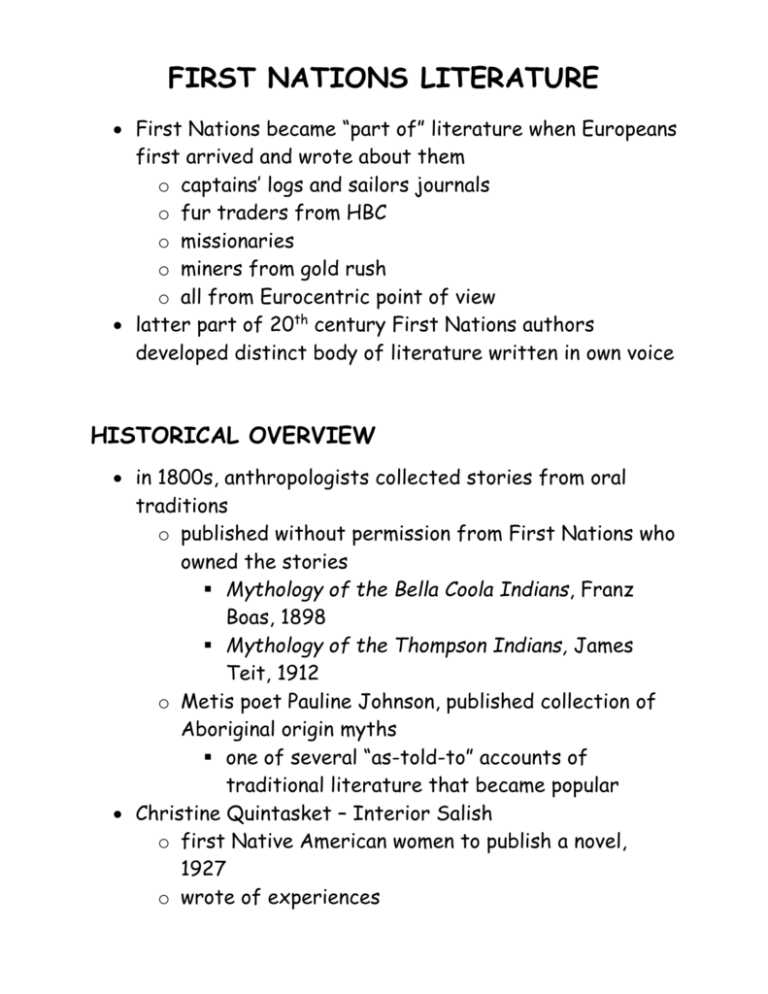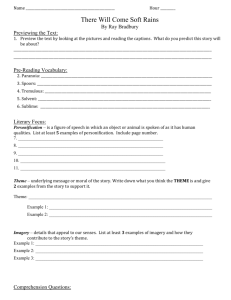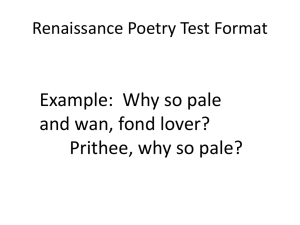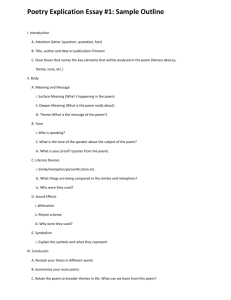Chapter 15 notes and assignments
advertisement

FIRST NATIONS LITERATURE First Nations became “part of” literature when Europeans first arrived and wrote about them o captains’ logs and sailors journals o fur traders from HBC o missionaries o miners from gold rush o all from Eurocentric point of view latter part of 20th century First Nations authors developed distinct body of literature written in own voice HISTORICAL OVERVIEW in 1800s, anthropologists collected stories from oral traditions o published without permission from First Nations who owned the stories Mythology of the Bella Coola Indians, Franz Boas, 1898 Mythology of the Thompson Indians, James Teit, 1912 o Metis poet Pauline Johnson, published collection of Aboriginal origin myths one of several “as-told-to” accounts of traditional literature that became popular Christine Quintasket – Interior Salish o first Native American women to publish a novel, 1927 o wrote of experiences roundup of last buffalo residential school attempting to take away her language reflects upheaval of communities o strong advocate First Nations rights and justice o criticism of her writing – influenced by non-Native editors to write for popular audience first collection of stories by Aboriginal person in BC o Son of Raven, Son of Deer, George Clutest, 1967 o lecturer teaching Native culture in Cdn schools numerous life histories by First Nations in collaboration with non-First Nations writers o Stoney Creek Woman: Sai’k’uu Ts’eke – story of Mary John as told to Bridget Moran ISSUES IN FIRST NATIONS PUBLISHING publishing is process of taking written material and making it available to public in form of print o signed contract, publisher acquires right to edit and publish material by an author in return for payment publishing companies predominantly Euro-Cdn o Aboriginal writers encounter difficulty in getting published o publishers gave preference to non-Aboriginal writers about First Nations people led to inaccurate and sometimes racist portrayals o when published, often gave up control of content and style struggled for editorial control over what published about First Nations o publishing with small companies gave more control books not necessarily reviewed by major newspapers or receive wide readership o only one Aboriginal publishing group in BC Theytus Books LITERATURE STUDY CONTEMPORARY ABORIGINAL LITERATURE IN BC in 1970s, Aboriginal people began to write own accounts of their history and place in Cdn society in 1980s, First Nations women writing about their lives were getting published o developed unique narrative voices influenced by oral tradition, metaphors with traditional meanings and characters with transformational powers o sometimes use “rez” language rhythm and patterns of speech in First Nations communities use language and grammar familiar to audience in 1990, En’owkin Center published first issue of journal Gatherings o sampling of current Aboriginal literature o continues to be published each year in 1990s, non-First Nations presses began to publish First Nations writers o wider distribution o 2 compilations of Okanagan Elder’s oral storytelling also published gives voice to Elders cultural knowledge valuable to younger First Nations people “to take charge of our own cultural revitalization” o Metis writers and poets published books with literary presses o First Nations scholars re-wrote BC history o several First Nations accounts of residential school experiences in BC published CULTURAL APPROPRIATION to appropriate = to take possession of it, especially unlawfully, for oneself o mid 1980s, cultural appropriation referred primarily to non-Aboriginal writers using First Nations’ beliefs, customs, ceremonies, and sacred stores without permission incorporating into their work in ways not intended to be used stereotypes contemporary First Nations people real voices get drowned with many First Nations writers, no justification for writers outside the culture appropriating First Nations themes or issues not that can’t use, but shouldn’t interpret or evaluate the spiritual beliefs without specific approval “THIS GUN IS FOR ME” REFLECTION / QUIZ Names: ________________________ LITERATURE STUDY In small groups: At each station you’ll find some readings. Some stations may have poems, while others have short stories. There will be one station with a listing of BC First Nations’ published works. Read the works at the stations and as a group answer the questions. SELF-PORTRAIT: MICROCOSM, or, SONG OF MIXED-BLOOD 1. What does the author “hunt” with? _________________________ 2. What does he think he should be hunting with? ____________________ 3. What is the conflict in the poem? _________________________________________________________ _________________________________________________________ _________________________________________________________ 4. What is the theme of the poem? ________________________________ 5. What is a possible alternate theme? _____________________________ GAAL COMES UPRIVER 1. Who is Gaal? _______________________________________________ 2. Can Gaal be a metaphor for the First Nations’ people? Explain using specific examples from the text. _________________________________________________________ _________________________________________________________ _________________________________________________________ _________________________________________________________ _________________________________________________________ 3. What is the theme of this poem? _______________________________ 4. What is a possible alternate theme? _____________________________ THE HOCKEY GAME 1. Why couldn’t the boy stay at the house? _________________________________________________________ 2. Why doesn’t he want to be seen by the neighbours? _________________________________________________________ _________________________________________________________ 3. Why did the folks back home play hockey? _________________________________________________________ 4. Why did the boy go to Robert’s house? ____________________________ 5. Why did he think he might get food there? _________________________________________________________ _________________________________________________________ 6. What differences can be said about the landlady’s family and the neighbours? _________________________________________________________ _________________________________________________________ _________________________________________________________ _________________________________________________________ _________________________________________________________ 7. What is the theme of the story? ________________________________ 8. What is a possible alternate theme? ______________________________ COYOTI LOST IN A CITY 1. Who is Coyoti? _____________________________________________ 2. Where does Coyoti really belong? _______________________________ 3. What does the author think is the reason for his return? _________________________________________________________ _________________________________________________________ _________________________________________________________ 4. What is the theme of the poem? ________________________________ 5. What is a possible alternate theme? _____________________________ THE OLD MAN’S LAZY 1. Why does the Indian Agent think the Old Man is lazy? _________________________________________________________ 2. What are the Old Man’s thoughts on the fence? _________________________________________________________ _________________________________________________________ 3. Why’d he take to visiting? _________________________________________________________ 4. What changed his children’s attitudes about his place? _________________________________________________________ _________________________________________________________ 5. What are some possible reasons why they can’t return? _________________________________________________________ _________________________________________________________ 6. What is the fence likened to? Why? _________________________________________________________ _________________________________________________________ 7. What is the theme of the poem? ________________________________ 8. What is a possible alternate theme? _____________________________ CHARLIE 1. What “wall” separates the girls and the boys in the eating room? _________________________________________________________ 2. What is the principal compared to? _____________________________ 3. What is the best part of the boy’s incarceration? _________________________________________________________ _________________________________________________________ 4. What is a possible reason for using the word “incarceration”? _________________________________________________________ _________________________________________________________ 5. Why didn’t he think it would take long to get home? _________________________________________________________ _________________________________________________________ _________________________________________________________ 6. What is the eventual outcome? _________________________________ 7. Is this good or bad? Explain _________________________________________________________ _________________________________________________________ 8. What are your groups’ feelings about this story? _________________________________________________________ 9. What is the theme of the story? ________________________________ RESEARCHING DIFFERENT GENRES 1. Who is the most published author in BC, with how many works published? _________________________________________________________ 2. Who is the most published author outside of BC, with how many works published? _________________________________________________ 3. How many works are published by Theytus Books? ___________________ 4. Where is Theytus Books (City, Province)? __________________________ 5. Which genre by Aboriginal authors has the most published? ________________________________________________________ 6. Which genre is the least published? _____________________________ 7. What might be some reasons for this discrepancy? _________________________________________________________ _________________________________________________________ _________________________________________________________ _________________________________________________________ _________________________________________________________ Name: _______________ “THIS GUN IS FOR ME” By Joseph A Dandurand This poem ties together many topics discussed in this chapter. Read the poem and brief explanation on creative non-fiction. Answer the following questions. Creative non-fiction = blend of non-fiction and fiction. Some features include: Holistic – presents a unique world view Grounded in the writer’s self: author is personally engaged Narrative base: grounded in real world, developed scenes and characters Uses interesting language: details, often “everyday” language, metaphors and imagery 1. Could this poem also be called creative non-fiction? What elements of creative non-fiction can you find in it? _________________________________________________________ _________________________________________________________ _________________________________________________________ 2. What emotions are expressed in this piece? _________________________________________________________ 3. Write about “Hollywood Indians” in terms of cultural appropriation. What is the poet’s attitude towards them? _________________________________________________________ _________________________________________________________ _________________________________________________________ _________________________________________________________ 4. What does the poem say about the writing experience? What do you think he means when he says “each poem has taken its toll on me”? _________________________________________________________ _________________________________________________________ _________________________________________________________ 5. How is Aboriginal identity reflected in this poem? _________________________________________________________ _________________________________________________________ _________________________________________________________








